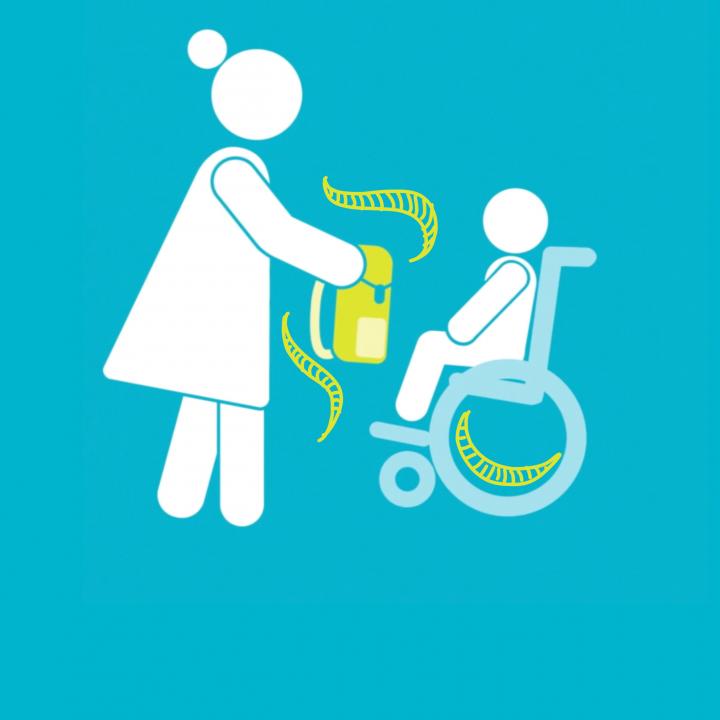IEP Checklist
As a parent or family member your input is critical. Here is a quick checklist for each step in the Individualized Education Plan (IEP) development process.
An IEP is usually set to cover a year, establishing the educational plan for that time frame. While, the IEP team relies on you for current information, we also need you for big-picture thinking. For example, what will your child be doing at 21 years old? Each IEP we develop will be the way we get there! Nothing can replace consistent communication throughout the school year and active participation from each IEP team member. That is the best approach, but we hope this check list can help!
Adapted from the SeekFreaks IEP Checklist- Parent/Family Version from the Exceptional Children’s Assistance Center (ECAC)

1. CHECK OUT THE INVITATION
- Is the purpose of the meeting clearly stated? If not, call the contact person provided or get in touch with the school to find out.
- Is my child 14 years old or turning 14 during the next 12 months? If so, did s/he receive a written invitation to the IEP meeting (required when planning for their transition to adulthood)?
- Who is attending? What are their roles in the meeting?
- Are there any team member requests for excuse from the meeting?
- Respond! Read, sign and return the Invitation to Conference/Prior Notice as soon as possible and keep a copy for your records. Include in writing any of the following that apply:
- Suggestions for alternative meeting dates or times
- Request to participate by conference call if needed
- Send a list of anyone you are inviting. Consider inviting a friend, relative, outside professional or note taker
2. PREPARE FOR THE MEETING- Get organized
- Keep a running list of concerns or issues that you wish to discuss sometimes it is helpful to record them in your phone. Maintaining this list throughout the year can be best.
- Request a copy of any proposed IEP draft, well in advance of the meeting. Make notes on these suggestions, contact staff to discuss ahead of the meeting, bring your ideas to the IEP meeting.
- Approve or reject team members excusal request, if needed
- Inform your IEP team if you plan to record the meeting
- Organize your child’s paperwork in a way that makes sense to you.
- Request any missing documents or copies of records
3. REVIEW - LAST YEAR’S INDIVIDUALIZED EDUCATION PLAN FOR YOUR CHILD
- Carefully read the present level of performance from last IEP, make notes about changes
- Read report cards and progress reports on your child’s goals, make notes
- Check out work samples, record your observations or ideas
- Read the summary from evaluations/assessment results
- Refresh your memory by skimming over notes/email/phone call logs, any communication about your child
- Review behavior plans, make notes and add ideas
4. PREPARE FOR THE MEETING- Reflect
- Ask your child what they want to work on, what is working well, anything they want people to know for this year?
- Review all materials and consider:
| 1 |
What has been accomplished? |
| 2 |
What has worked well? |
| 3 |
What needs more work? |
| 4 |
What are my concerns? What are my child’s concerns? |
| 5 |
Are we making sufficient progress? |
- Write down and prioritize a list of any questions, concerns or requests that you have. Indicate which person or role (teacher, OT, SLP) you need to address.
- Draft ideas for goals, possible data to collect/where/when best to collect
- Create a vision statement for your child’s life both now and for the future. Think about:
| 1 |
What does your child like to do? Want to do? |
| 2 |
What chores does s/he do? What type of work does s/he like? |
| 3 |
What does s/he like to do for fun? What does your family enjoy doing together? |
| 4 |
What does your community offer for physical activities? Social activities? Volunteering? |
| 5 |
Five years from now, how will they spend their time? |
- Send the other members of your team important notes and drafted goals, include any topics or issues that you want to discuss and address:
| 1 |
Goals don't need to be formal or final, just ideas |
| 2 |
Have you seen a strength that can be used? |
| 3 |
How do you motivate your child? What routines or strategies are helpful? |
- Gather supporting documents such as community-based therapist notes, private evaluations, research-based fact sheets, etc. Feel free to ask folks working with your child for any input for the new IEP?
- Prepare your child to participate in the meeting, if they are attending.
| 1 |
What parts of the meeting can s/he lead (e.g. introductions, rules for the meeting, progress on goals)? |
| 2 |
If they are not attending, what does s/he want for next year? |
| 3 |
How can the team help her/him at school? |
- Consider bringing pictures or a short video of your child to the meeting.
- Send a reminder note to anyone you have invited to the meeting.
- Ask the teacher(s) about your child’s progress and any specific concerns or ideas they have for the upcoming year.
5. PARTICIPATE IN THE MEETING- Stay engaged!
Each member of the IEP Team has an important part to play, especially you. Everyone must be prepared to work together, ask questions, set priorities and contribute to the IEP. The Team must consider and use a wide variety of data and other information, including the information you share, to create an IEP that is works for your child.
- Remember to bring your notes, records and any other information you need for the meeting. Don’t forget a pencil/pen/paper and remember to bring your child’s pictures or video if you want.
- Arrive early, if at all possible.
- Connect with any person(s) that you invited before entering meeting.
- Thank the other team members for their work, efforts and ideas for your child.
- Request introductions, if necessary, and clarify everyone’s role at the meeting.
- Ask who is responsible for taking the meeting notes or minutes. If something is unclear, ask for the notes to be read. Ask for detail to be included if you think it is important.
- Review the IEP meeting agenda, make additions from your notes while the meeting gets underway.
- Share your ideas, opinions and feelings throughout the meeting.
- Listen carefully to what is being said. It can be helpful to ask people to re-state something another way if it seems complicated or difficult to understand.
- If something is not clear, ask questions as needed so you fully understand before moving forward. If there is an abbreviation or test name that is unfamiliar, be sure to ask! Others probably wondering too…
- Monitor your non-verbal communication- fix your face…open your arms…avoid sound effects
- Request a brief break if you or someone else needs one!
- Work to gain consensus. Effective IEP are not characterized by unanimous agreement but by plans that are driven by student data and compromise. Each member does not have to agree with every aspect of the plan, but every member can support the plan.
Fifteen minutes before the meeting ends:
- Check to see if all your concerns have been addressed. If not, two meetings are better than one super long, incomplete one! Ask for another meeting if there are unresolved issues, if time ran out or if the team is not making progress.
- Make sure that IEP is clear, the wording throughout can be understood by anyone – even if they were not present at the meeting!!
- Identify who is responsible for each part of the IEP and any follow-up activity.
- Sign the IEP.
- Your signature documents your attendance and participation in developing the IEP.
- If you disagree with any part of the IEP, state your concern(s) in writing on the IEP form next to your signature or in the margin.
- Thank the other team members for their participation, efforts and ideas for your child.
- You receive a copy of the completed IEP. This is the legally binding copy even if electronic systems are used. Be sure to take that copy, even if a cleaner copy will be sent.
6. AFTER THE MEETING- Wrap up while it is fresh
- Review any materials you received, decide what you need to keep. Shred those you discard and organize those you keep.
- Review the IEP, while the meeting is still fresh in your memory. Contact the school in writing if any clarifications or corrections are needed. As always, keep these documents.
- Note any suggestions you have about how to improve the process, goals or data.
- Write “Thank You” emails or notes.
- Write letters of clarification to address any concerns, questions, overlooked areas, etc., if needed.
- Consider sharing a copy of the IEP with other professionals working with your child.
- Ensure everyone who works with your child (health care providers, physicians, therapists), ALL of your child’s teachers, are aware that there is a new IEP.
7. Ongoing Engagement - A new IEP is a new beginning. Stay connected throughout the year:
- Participate in any data collection. Often home behaviors, sleep and performance in other places can be the key to understanding and provide insight to how student progress can be accelerated.
- COMMUNICATE with your child’s teachers, coaches, related service providers, all instructional staff. Share successes and address any issues as they arise. Ask questions! Let your school team know if you plan to get new equipment, if you child may need medical procedures or interventions, if there are big family changes coming…knowledge is power and allows you all to work together proactively.
- Figure out how to look at your child’s data as a team. Is s/he making adequate progress, are there changes to make? Review the IEP periodically. Respond to progress reports and report cards.
- Request an IEP meeting to discuss changes if needed.
8. Repeat, start again at #1…
We hope these lists are helpful to you for this IEP meeting but also all year long. We also have a similar list for students and teachers/related services providers. Please share these lists with anyone and let us know if you have an idea about something that should be included here. The key to a great IEP is working with the whole team and employing student performance data from actual school routines. If we use data and collaborate well, the student goals will be meaningful and will get accomplished. Everyone must do her/his part so we can get your child where they want to be!
SeekFreaks IEP Checklist
Parent/Family Version
Adapted from the Exceptional Children’s Assistance Center (ECAC) - North Carolina
1-800-962-6817 or www.ecac-parentcenter.org
Visit ECAC’s web site, www.ecac-parentcenter.org, to download additional helpful tools. Please note, may be specific to North Carolina.
Visit these web sites, if you child is 14 or older for information and helpful tools about work, school and community engagement after school is finished:
https://transitionta.org/
http://www.pacer.org/transition/
http://www.parentcenterhub.org/transitionadult/
Being knowledgable about your child's IEP and their disability can help you become a better advocate for your child. The more you know, the more prepared you will be to navigate the world of special education.







